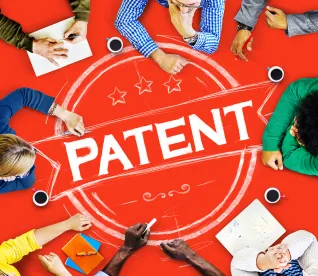Takeaway: Rather than looking to the general concept of a product for which a design is claimed, the appropriate obviousness inquiry must focus on the “distinctive visual appearances” of the claimed design and the reference with which it is being compared.
In its Decision, the Board did not institute inter partes review of the sole claim of the challenged ‘197 design patent. According to the Board, the Petition had not established a reasonable likelihood of prevailing on any asserted ground of unpatentability in respect to that claim.
The ‘197 patent claims a design for a bottle. Petitioner had challenged the patentability of the claim based on the following grounds: (1) obviousness under 35 U.S.C. § 103 in view of Round Ink Bottle, CH No. 146, and CH No. 284; (2) obviousness under 35 U.S.C. § 103 in view of Round Ink Bottle, CH No. 146, CH No. 284, and Trayser; (3) obviousness under 35 U.S.C. § 103 in view of CH No. 146 and CH No. 284; and (4) obviousness under 35 U.S.C. § 103 in view of CH No. 146, CH No. 284, and Trayser. Petitioner submitted a declaration of Mr. Kurt Schlesselman in support of its positions.
Petitioner had submitted a proposed claim construction; Patent Owner had not. The proposed claim construction submitted by Petitioner was in narrative form. The Board did not adopt Petitioner’s proposed claim construction. Instead, it “[construed] the claim to be the ornamental design of the bottle, as illustrated in Figures 1–7” and, in addition, verbally described “certain distinctive features of the claimed bottle[.]” The Board also concurred with Patent Owner that a designer of ordinary skill in this instance would not necessarily have a college degree. The Board then indicated that it would use the usual two-step inquiry for conducting its obviousness analysis. The first step of this inquiry is that a primary reference must be found that has basically the same design characteristics as the claimed design. The first step, in turn, has two parts, requiring the Board to “(1) discern the correct visual impression created by the patented design as a whole; and (2) determine whether there is a single reference that creates ‘basically the same’ visual impression.” The second step of the inquiry involves modifying the primary reference by the secondary reference(s) “to create a design that has the same overall visual appearance as the claimed design[,]” but only if the secondary references are “so related [to the primary reference] that the appearance of certain ornamental features in one would suggest the application of those features to the other.”
The Board then conducted a detailed analysis of the asserted references using the two-step inquiry. The Board agreed with Patent Owner with respect to asserted grounds (1) and (2), finding that “Petitioner [had] failed to meet its burden for several reasons.” In particular, the Board was “not persuaded that the Round Ink Bottle creates the same visual impression as the claimed bottle design, and accordingly [determined] that the Round Ink Bottle is not an appropriate primary reference.” Thus, the Board agreed with Patent Owner on asserted grounds (1) and (2) without ever reaching the second step of the two-step inquiry.
The Board also agreed with Patent Owner with respect to asserted grounds (3) and (4). In particular, the Board was “not persuaded by Petitioner, or its Declarant, that relative dimensions, at least in the case of a ubiquitous commercial product such as a bottle, are by themselves sufficient to evoke an accurate visual comparison between two bottles.” Referencing Apple, Inc. v. Samsung Electronics Co., 678 F.3d 1314, 1332 (Fed. Cir. 2012), the Board concluded that it “must look more closely at the distinctive visual appearances of the CH No. 146 bottle and the claimed design.” The Board then noted that although similarities existed in the relative proportional dimensions between the claimed bottle and that of the primary reference (CH No. 146), the Board nevertheless found that “Petitioner’s analysis, and that of its Declarant, [fail] to address the readily apparent fact that the claimed bottle is depicted as transparent and that various distinctive features of the claimed bottle are clearly visually evident due to the transparency.” This led the Board to conclude that “[i]t is apparent from the visual comparison of the [non-transparent] CH No. 146 bottle to the claimed [transparent] bottle in light of the proper verbal description that the prior art bottle does not create the same visual impression as the claimed bottle design.” Because the Board deemed that Petitioner had now shown that the CH No. 146 bottle is an appropriate primary reference, the Board did not feel the need to reach the second step of the obviousness analysis for asserted grounds (3) and (4).
Vitro Packaging, LLC v. Saverglass, Inc., IPR2015-00947
Paper 13: Decision Denying Institution of Inter Partes Review
Dated: September 29, 2015
Patent: D526,197 Before: Hyun J. Jung, Scott A. Daniels, and Carl M. DeFranco Written by: Daniels
Related Proceedings: Saverglass, Inc. v. Vitro Packaging, LLC., Civil Action No. 2:14-cv-05434-WFK-AKT (E.D.N.Y. 2014)



 />i
/>i

